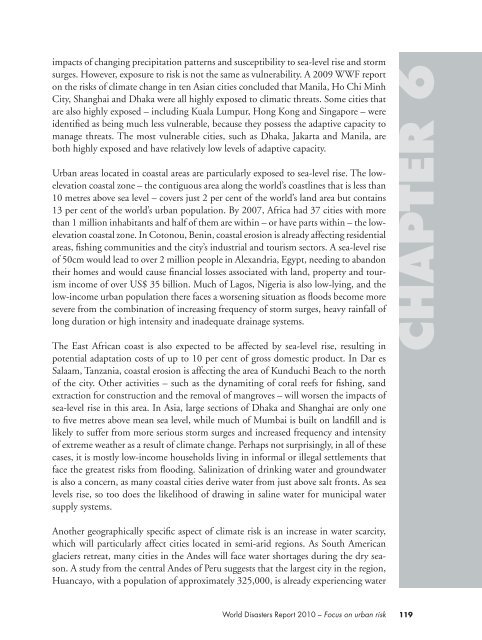World Disasters Report 2010 - International Federation of Red Cross ...
World Disasters Report 2010 - International Federation of Red Cross ...
World Disasters Report 2010 - International Federation of Red Cross ...
Create successful ePaper yourself
Turn your PDF publications into a flip-book with our unique Google optimized e-Paper software.
impacts <strong>of</strong> changing precipitation patterns and susceptibility to sea-level rise and storm<br />
surges. However, exposure to risk is not the same as vulnerability. A 2009 WWF report<br />
on the risks <strong>of</strong> climate change in ten Asian cities concluded that Manila, Ho Chi Minh<br />
City, Shanghai and Dhaka were all highly exposed to climatic threats. Some cities that<br />
are also highly exposed – including Kuala Lumpur, Hong Kong and Singapore – were<br />
identified as being much less vulnerable, because they possess the adaptive capacity to<br />
manage threats. The most vulnerable cities, such as Dhaka, Jakarta and Manila, are<br />
both highly exposed and have relatively low levels <strong>of</strong> adaptive capacity.<br />
Urban areas located in coastal areas are particularly exposed to sea-level rise. The lowelevation<br />
coastal zone – the contiguous area along the world’s coastlines that is less than<br />
10 metres above sea level – covers just 2 per cent <strong>of</strong> the world’s land area but contains<br />
13 per cent <strong>of</strong> the world’s urban population. By 2007, Africa had 37 cities with more<br />
than 1 million inhabitants and half <strong>of</strong> them are within – or have parts within – the lowelevation<br />
coastal zone. In Cotonou, Benin, coastal erosion is already affecting residential<br />
areas, fishing communities and the city’s industrial and tourism sectors. A sea-level rise<br />
<strong>of</strong> 50cm would lead to over 2 million people in Alexandria, Egypt, needing to abandon<br />
their homes and would cause financial losses associated with land, property and tourism<br />
income <strong>of</strong> over US$ 35 billion. Much <strong>of</strong> Lagos, Nigeria is also low-lying, and the<br />
low-income urban population there faces a worsening situation as floods become more<br />
severe from the combination <strong>of</strong> increasing frequency <strong>of</strong> storm surges, heavy rainfall <strong>of</strong><br />
long duration or high intensity and inadequate drainage systems.<br />
The East African coast is also expected to be affected by sea-level rise, resulting in<br />
potential adaptation costs <strong>of</strong> up to 10 per cent <strong>of</strong> gross domestic product. In Dar es<br />
Salaam, Tanzania, coastal erosion is affecting the area <strong>of</strong> Kunduchi Beach to the north<br />
<strong>of</strong> the city. Other activities – such as the dynamiting <strong>of</strong> coral reefs for fishing, sand<br />
extraction for construction and the removal <strong>of</strong> mangroves – will worsen the impacts <strong>of</strong><br />
sea-level rise in this area. In Asia, large sections <strong>of</strong> Dhaka and Shanghai are only one<br />
to five metres above mean sea level, while much <strong>of</strong> Mumbai is built on landfill and is<br />
likely to suffer from more serious storm surges and increased frequency and intensity<br />
<strong>of</strong> extreme weather as a result <strong>of</strong> climate change. Perhaps not surprisingly, in all <strong>of</strong> these<br />
cases, it is mostly low-income households living in informal or illegal settlements that<br />
face the greatest risks from flooding. Salinization <strong>of</strong> drinking water and groundwater<br />
is also a concern, as many coastal cities derive water from just above salt fronts. As sea<br />
levels rise, so too does the likelihood <strong>of</strong> drawing in saline water for municipal water<br />
supply systems.<br />
Another geographically specific aspect <strong>of</strong> climate risk is an increase in water scarcity,<br />
which will particularly affect cities located in semi-arid regions. As South American<br />
glaciers retreat, many cities in the Andes will face water shortages during the dry season.<br />
A study from the central Andes <strong>of</strong> Peru suggests that the largest city in the region,<br />
Huancayo, with a population <strong>of</strong> approximately 325,000, is already experiencing water<br />
<strong>World</strong> <strong>Disasters</strong> <strong>Report</strong> <strong>2010</strong> – Focus on urban risk<br />
119

















